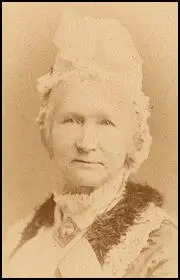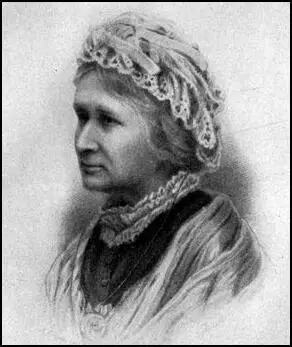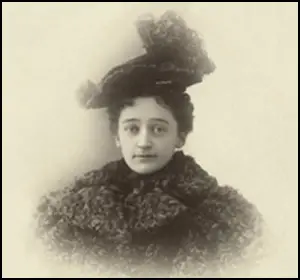Clementia Taylor

Clementia Doughty, one of twelve children of John Doughty, a farmer and tanner, and his wife, Mary Simons Doughty, was born on 17th December 1810 at Brockdish, Norfolk. (1)
Clementia (known to her friends and family as Mentia) was employed as governess to the daughters of a Unitarian minister, John P. Malleson (1796–1869), who ran a boys' boarding-school in Hove. (2)
The Englishwoman's Review later described her as a person who "was somewhat tall as well as slight; the features were refined and regular - the head well formed and carried, the hair bright blonde, the brow broad, the speaking grey eyes rather deep set, the nose slightly aquiline, a certain firmness about the mouth, a delicately pointed chin." (3)
While she was a governess he met businessman Peter Alfred Taylor, the son of Peter Taylor. His father had invested money in George Courtauld & Company, when his cousin, George Courtauld, was short of capital in 1817. The following year, George left for America and Samuel Courtauld joined Taylor in expanding the business. Over the next few years Courtauld & Taylor purchased steam-engines and power-looms for its mills in Braintree, Halstead and Bocking. (4)
Clementia Taylor Salon
Clementia married Peter Alfred Taylor on 27th September 1842. In 1845 the Taylors met Giuseppi Mazzini, the Italian patriot, who made an indelible impression on them, and they became his close friends and supporters. A secret hiding place was prepared for Mazzini in the Taylors' home, in case his life should be threatened. In the late 1840s Taylor helped to found the Society of Friends of Italy, and as its first treasurer was its primary fund-raiser. The Taylors kept open house for leading radicals from Britain, Europe, and America, from the early 1850s, in Powis Place, Great Ormond Street, London. (5)
One of the regular visitors was Elizabeth Malleson. She later recalled: "Those monthly parties during the London season were unique and very enjoyable, for Mentia and her husband… were admirably free of class prejudice in persons and opinions, so that all kinds of literary people - refugees from several countries - artists and humble lovers of social enjoyment, mingled with supporters of 'causes' of all kinds." (6)
The American novelist, short story writer, poet and anti-slavery campaigner, Louisa May Alcott spent time at the Taylor's Salon: "I consider her a model Englishwoman - simple, sincere and accomplished, full of good sense, intelligence and energy. Her house is open to all, friend and stranger, black and white, rich and poor. Great men and earnest women meet there.… Though wealthy and living in an historical mansion… the hostess is he simplest dressed lady." (7)
In February 1862 Peter Alfred Taylor was elected as advanced Liberal MP for Leicester. Soon afterwards he withdrew his capital of £72,000 from the business and concentrated on his political career. In the House of Commons Taylor worked closely with John Stuart Mill and Henry Fawcett in supporting women's suffrage. (8)
Ladies' London Emancipation Society
Clementia Taylor was an active opponent of slavery and on the outbreak of the American Civil War she established an English branch of the Freemen's Aid Association, an organisation that provided a supply of teachers from the North and provided housing for them, to set up and teach in schools in the South for freedmen and their children. (9)
Sarah Parker Remond (1824–1894), a young black woman who toured Britain lecturing on the slavery issue, went to live with Clementia and Peter Taylor. In 1863 Clementia joined with Harriet Martineau, Elizabeth Malleson, Mary Estlin, Sarah Parker Remond, Eliza Wigham and Charlotte Manning to form the Ladies' London Emancipation Society. (10)
The Enfranchisement of Women Committee
In October 1866, Clementia Taylor helped to establish Enfranchisement of Women Committee. However, its original name was the "Enfranchisement of Unmarried Women and Widows, Possessing the Due Property Qualification". (11) The society attracted 88 members including Emily Davies, Lydia Becker, Jessie Boucherett, Barbara Bodichon, Helen Blackburn, Alice Westlake, Peter Alfred Taylor and John Westlake. Louisa Garrett Smith was honorary secretary. It had "for its object the abolition of the legal disability which at present disqualifies women as such from voting for Members of Parliament." It hoped to achieve this aim by presenting further petitions to parliament in order to demonstrate the earnestness of women in this matter." (12)
Helen Taylor had objected to having men on the Enfranchisement of Women Committee. She was supported by her stepfather, John Stuart Mill, who argued it would be educationally useful to have an exclusively female's woman's movement. Barbara Bodichon disagreed, citing her experience of meeting leaders of the women's movement in America. She came home of the opinion that the women there had wasted their energy by trying to do too much at once, by not working with men and by being too sentimental. (13)
Clementia Taylor, wrote to Helen Taylor, about this issue: "I read.... your objection to a mixed committee of men and women. Now my experience bears testimony to the practical benefit resulting from the combined efforts of men and women - we gain advantage from the more logical and from the more practical qualities of men - and men gain from women more earnestness of purpose - more subtle views of questions - I believe so strongly in the reciprocal benefit of both I would from the earliest age have boys and girls educated together - associated together in all the higher purposes of life and believe that morally as well as mentally the word would gain much - but to our committee I deeply grieve that we are not at one upon this question, it was not without due thought and consideration that we determined upon the mixed working committee... I have been on committees formed of women only and upon more - men and women together - the latter certainly acted more effectively and I believe that the committees of men only would be less effective than if women were associated with them." (14)

Taylor became frustrated and disillusioned by the work of the Enfranchisement of Women Committee and told Helen Taylor: "There should be a large meeting of the earnest friends of the cause to decide upon future work, organisation etc. and form a new committee - have a paid Secretary - officials - such a Committee as you will be induced to join - and in which I shall not feel myself as a Pariah." (15)
London National Society for Women's Suffrage
In July 1867 the Enfranchisement of Women Committee was dissolved. Clementia Taylor was the driving force behind the formation of the London Society for Women's Suffrage. From the outset it was intended that this new society in London was to be part of a federated scheme. Taylor wrote that she was willing "to undertake the secretary-ship of the London Central Committee the centres all to be affiliated together and in constant correspondence with each other so that no work shall be repeated. I think different centres will be necessary for local actions - but no centre to take any important step without reference to all the other centres." (16)
It was Clementia Taylor who suggested the name "The London Woman Suffrage Society" and she also argued that it should cooperate closely with the recently formed Manchester Society for Suffrage. (17) The first committee of the society included Clementia Taylor, Frances Power Cobbe, Millicent Garrett Fawcett, Katherine Hare and Margaret Bright Lucas. Other members included Helen Taylor, Lydia Becker, Barbara Bodichon, Jessie Boucherett, Emily Davies, Francis Mary Buss, Dorothea Beale, Anne Clough, Rhoda Garrett, Lilias Ashworth Hallett, Louisa Garrett Smith, Priscilla McLaren, Elizabeth Garrett, Alice Westlake, Catherine Winkworth and Kate Amberley. (18)
Clementia Taylor took the main role in developing the strategy for the London Society for Women's Suffrage: "Our present course of action is the dissemination of information throughout the kingdom and it seems to me, we cannot apply our pounds to better purpose than by the publication of good papers." (19) This included Helen Taylor's pamphlet's The Claims of Englishwomen to the Suffrage Constitutionally Considered. (20)
It was decided to allow men to play an active role in the London Society for Women's Suffrage. Rachael Strachey pointed out: "At that date it was usual, when men and women were on a committee together, for the men to do all the talking, but in these early suffrage groups neither the men nor the women were of that kind. They practised, as well as believed in, equality, to the great advantage of their cause." (21)
The first public meeting organised by the London Society for Women's Suffrage was held in the Gallery of the Architectural Society in Conduit Street on 17th July 1869. The chair was taken by Clementia Taylor and the audience heard for the first time women speak from a London platform in the furtherance of their cause. The following year on 26th March 1870, another meeting was held, this time in the Hanover Square Rooms, again with Taylor in the chair. Among the speakers were Millicent Garrett Fawcett, Katherine Hare, Harriet Grote, Helen Taylor, John Stuart Mill and Charles Wentworth Dilke. (22)

In November 1871, Jacob Bright suggested at the annual general meeting of the Manchester Society for Women's Suffrage that greater pressure could be applied on members of the House of Commons by establishing a standing central committee in London representing all the suffrage societies. John Stuart Mill argued against having two organisations in favour of women's suffrage but Clementia Taylor agreed with Bright and as a result resigned from the London Society for Women's Suffrage. Her friend, George Eliot, wrote to her: "Welcome back from your absorption in the franchise! Somebody else ought to have your share of work now, and you ought to rest." (23)
Women's Rights Campaigns
Taylor did not take Eliot's advice and she now joined the Central Society of the National Society for Women's Suffrage. It first meeting was held on 17th January 1872. The first executive committee included, Frances Power Cobbe, Priscilla Bright McLaren, Agnes Garrett, Rhoda Garrett and Lilias Ashworth Hallett. In 1874 Clementia Taylor, Millicent Garrett Fawcett, Florence Nightingale and Harriet Martineau joined. (24)
Clementia Taylor was also involved in the campaign for women's doctors. In 1874 Elizabeth Garrett Anderson, Sophia Jex-Blake, Emily Blackwell and Elizabeth Blackwell established a London Medical School for Women. Jex-Blake expected to put in charge but Garrett believed that her temperament made her unsuitable for the task and arranged for Isabel Thorne to be appointed instead. To her students Garrett Anderson offered a model of female professionalism in which "the first thing women must learn is to dress like ladies and behave like gentlemen". (25) Taylor was a member of the hospital's general committee. (26)
Clementia Taylor was also on the executive committee of the Married Women's Property Committee (1876–82); a member of the committee of the Ladies Association for the Repeal of the Contagious Diseases Acts; treasurer of the Personal Rights Association. She was a member of the council of the Women's Franchise League when it was formed in 1889, and later joined the Women's Emancipation Union, still being a member in 1897. As Elizabeth Crawford pointed out: "In all her associations Clementia Taylor demonstrated a commitment to a radical interpretation of women's rights." (27)
Clementia Taylor died at the age of ninety-eight, on 11 April 1908, at her home, 16 Eaton Place, Brighton, after some years of failing health and memory.
Primary Sources
(1) The Englishwoman's Review: Volume 39 (1908)
Clementia Taylor was somewhat tall as well as slight; the features were refined and regular - the head well formed and carried, the hair bright blonde, the brow broad, the speaking grey eyes rather deep set, the nose slightly aquiline, a certain firmness about the mouth, a delicately pointed chin.
(2) Elizabeth Malleson, Autobiographical Notes and Letters (1926)
Those monthly parties during the London season were unique and very enjoyable, for Mentia and her husband… were admirably free of class prejudice in persons and opinions, so that all kinds of literary people - refugees from several countries - artists and humble lovers of social enjoyment, mingled with supporters of "causes" of all kinds.
(3) Louisa May Alcott, Shawl-Straps (1873)
I consider her a model Englishwoman - simple, sincere and accomplished, full of good sense, intelligence and energy. Her house is open to all, friend and stranger, black and white, rich and poor. Great men and earnest women meet there.… Though wealthy and living in an historical mansion… the hostess is he simplest dressed lady.
(4) Clementia Taylor, letter to Helen Taylor (29th October, 1866)
I read.... your objection to a mixed committee of men and women. Now my experience bears testimony to the practical benefit resulting from the combined efforts of men and women - we gain advantage from the more logical and from the more practical qualities of men - and men gain from women more earnestness of purpose - more subtle views of questions - I believe so strongly in the reciprocal benefit of both I would from the earliest age have boys and girls educated together - associated together in all the higher purposes of life and believe that morally as well as mentally the word would gain much - but to our committee I deeply grieve that we are not at one upon this question, it was not without due thought and consideration that we determined upon the mixed working committee... I have been on committees formed of women only and upon more - men and women together - the latter certainly acted more effectively and I believe that the committees of men only would be less effective than if women were associated with them.
(5) Clementia Taylor, letter to Helen Taylor (4th March, 1867)
There should be a large meeting of the earnest friends of the cause to decide upon future work, organisation etc. and form a new committee - have a paid Secretary - officials - such a Committee as you will be induced to join - and in which I shall not feel myself as a Pariah.
(6) Clementia Taylor, letter to Helen Taylor (15th July, 1867)
Our present course of action is the dissemination of information throughout the kingdom and it seems to me, we cannot apply our pounds to better purpose than by the publication of good papers.
Student Activities
References
(1) David Simkin, Family History Research (16th September 2023)
(2) Elizabeth Crawford, Clementia Taylor: Oxford Dictionary of National Biography (23rd September, 2004)
(3) The Englishwoman's Review: Volume 39 (1908)
(4) Donald C. Coleman, Samuel Courtauld: Oxford Dictionary of National Biography (23rd September, 2004)
(5) Elizabeth Crawford, Clementia Taylor: Oxford Dictionary of National Biography (23rd September, 2004)
(6) Elizabeth Malleson, Autobiographical Notes and Letters (1926) page 98
(7) Louisa May Alcott, Shawl-Straps (1873) pages 281-2
(8) Alan Ruston, Peter Alfred Taylor: Oxford Dictionary of National Biography (5th January 2012)
(9) Elizabeth Crawford, Clementia Taylor: Oxford Dictionary of National Biography (23rd September, 2004)
(10) Elizabeth Crawford, The Women's Suffrage Movement: A Reference Guide 1866-1928 (2000) page 674
(11) Emily Davies, letter to Lydia Becker (6th April, 1867)
(12) Elizabeth Crawford, The Women's Suffrage Movement: A Reference Guide 1866-1928 (2000) page 206
(13) Barbara Bodichon, letter to Helen Taylor (October, 1866)
(14) Clementia Taylor, letter to Helen Taylor (29th October, 1866)
(15) Clementia Taylor, letter to Helen Taylor (4th March, 1867)
(16) Clementia Taylor, letter to Helen Taylor (12th June, 1867)
(17) Clementia Taylor, letter to Helen Taylor (20th June, 1867)
(18) Elizabeth Crawford, The Women's Suffrage Movement: A Reference Guide 1866-1928 (2000) pages 351-353
(19) Clementia Taylor, letter to Helen Taylor (15th July, 1867)
(20) Helen Taylor, The Claims of Englishwomen to the Suffrage Constitutionally Considered (1867)
(21) Rachael Strachey, The Cause: A Short History of the Women's Movement in Great Britain (1928) page 112
(22) Elizabeth Crawford, The Women's Suffrage Movement: A Reference Guide 1866-1928 (2000) page 352
(23) Elizabeth Crawford, Clementia Taylor: Oxford Dictionary of National Biography (23rd September, 2004)
(24) Elizabeth Crawford, The Women's Suffrage Movement: A Reference Guide 1866-1928 (2000) page 102
(25) Jo Manton, Elizabeth Garrett Anderson (1965) page 311
(26) Elizabeth Crawford, The Women's Suffrage Movement: A Reference Guide 1866-1928 (2000) page 677
(27) Elizabeth Crawford, Clementia Taylor: Oxford Dictionary of National Biography (23rd September, 2004)
xxx

